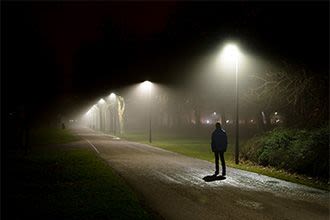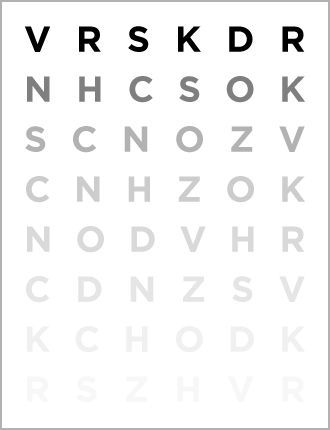How to Check Continuity on Night Vision
How does night vision work?
What is night vision?
Night vision, also called scotopic vision, is your natural ability to see in the dark. It kicks in when different components, in particular your pupils and retinas, work together inside your eyes. It can come in pretty handy when you need it.
How your eyes adjust to darkness
In a dark setting, your eyes like to gather as much light as possible. They do this by opening the pupils wide and allowing your eyes to catch as many rough outlines and shapes as they can.
In a brighter setting your pupils shrink back down, since they have all the light they need to see comfortably.
To witness this firsthand, stand in front of a mirror in a darkened room, then ask someone to turn on the lights. If you're fast enough, you'll see your pupils quickly shrinking.
This automatic process is one reason you have scotopic vision, but it doesn't show the entire picture. For that, you have to look at the microscopic cells in the back of your eyes.
There are millions of rod-shaped and cone-shaped cells along every eye's retina. These rods and cones are necessary for eyesight.
Rods and cones each react a little differently to varying types of light. When the right light strikes them, they send tiny impulses along your optic nerve and into the back of your brain. This is how vision happens.
While cones are great at registering bright lights, colors and fine details, they're not so useful for helping you see in the dark — that's where your rods come in.
Rods excel in peripheral vision and are much more sensitive to light photons, which makes them extremely helpful in low-light settings. Without rods scattered across your retinas, any sort of darkness would be virtually blinding.
But there's a catch: Rods can't process color. This is why your night vision usually isn't very colorful and often seems to be in black and white.
Look around next time you're lying in a darkened bedroom. Not very vibrant, is it?
Do humans have good night vision?
Last time you got up in the middle of the night, were you frustrated by just how little you could actually see?
Unfortunately, one of the downsides to being a human is that the night vision isn't great. At least compared to the rest of the animal kingdom.
And adjusting to the darkness certainly isn't a quick process for a human either. In fact, reaching your maximum level of night vision is almost painfully slow.
It takes your eyes 5 to 8 minutes to start adjusting to darkness, but they don't reach maximum adjustment until you've been in the dark for about 40 minutes.
But there's a good reason for all of this: Humans are primarily daytime beings. What they lack in night vision they make up for in vibrant colors and contrast during the day.
Animals that are nocturnal or spend more time in the dark tend to have better night vision. Cats and dogs, along with cows, horses and deer, have an iridescent coating behind the retina that boosts their scotopic vision.
This feature is called a tapetum lucidum, and it gives their eyes that colorful, reflective glare at night.
SEE RELATED: 11 questions answered about how animals' eyes work

Can your eyes see in total darkness?
If you've ever experienced a darkness so sweeping that you can't see your hand in front of your face, you'll know the answer is no.
Your eyes' rod cells may be hypersensitive, but they aren't so sensitive that they can make something out of nothing.
Your night vision works outdoors and in your home because it's almost never completely dark. There's always light creeping in from the moon, stars, streetlight or alarm clock.
Even the smallest amount of light can give your eyes enough to work with.
Walk far enough into an underground cavern, and you can experience true, absolute darkness for yourself. Without a light source, all forms of shape and motion will disappear, rendering your eyes useless. You would perceive this absence of light as complete blackness.
Artificial night vision
The visible light you see makes up only a tiny portion of the electromagnetic spectrum, a scale that includes every type of radiation.
Thermal (infrared) cameras focus on radiation just past the visible scale. Anything you feel as heat usually qualifies as infrared radiation.
Thermal cameras can function in total darkness, but only in the presence of objects that contain or emit heat. They're commonly used for seeing people or animals at night, since visible heat from the body creates a stark contrast to a cooler, darker background.
Since your eyes can't see infrared radiation, images or videos captured by thermal cameras have to be processed. Once the camera converts these infrared images, you're able to see objects that appear to be glowing.
The more traditional "green" night vision requires at least a small amount of light, similar to your own eyes. This technology slightly intensifies the dark image so you can see it better, and in greater detail. The green color lets us see the final product more distinctly than the grayscale or black and white of a human's un-aided night vision.
SEE RELATED: How do night vision goggles work?
How can I test my night vision?
Nighttime activities like driving involve much lower-contrast surroundings than they would during the day. The Pelli-Robson contrast sensitivity test is the most common method of testing your eyes' ability to distinguish between high and low contrast.
The Pelli-Robson test checks your ability to detect letters that become less contrasted with the white background as your eyes move down the chart.

The Pelli Robson contrast sensitivity chart tests your ability to detect letters that are gradually less contrasted with the white background as your eyes move down the chart.
The test is usually reserved for people with disorders that could affect their low-contrast vision, but you can also request it if you suspect your night vision could be impaired.
You can test your night vision at home too. Sciencing writer Emily Trudeau suggests a solution that requires little more than a bit of patience.
After letting your eyes adjust to darkness for about 20 minutes, focus directly on a small object and pick up as many details about the object as you can.
This is where it gets interesting. Remember the rod cells in your eyes that specialize in low light and peripheral vision? Look slightly to the side of the object for a moment. Now that the object is in your side vision, there's a good chance the object will now appear more clearly, since the rod cells in your eyes are hard at work.
Eye problems that can affect night vision
Certain eye conditions can make it very hard to see in low light. This symptom is called nyctalopia — night blindness.
Different levels of night blindness can be caused by:
-
Nearsightedness
-
Cataracts
-
Diabetes
-
Glaucoma
-
Retinitis pigmentosa
-
Glucose or vitamin A imbalances
Some of these conditions are more serious than others. If you're experiencing problems with your night vision, schedule a comprehensive eye exam.
READ MORE ON NIGHT VISION:
Tips to improve your driving at night
Night driving glasses: Help or hoax?
Should you wear polarized glasses while you're driving at night?
What is night myopia (nearsightedness)?
Night vision goggles and binoculars
Night blindness (nyctalopia)
Blurry vision at night
Page published on Friday, March 6, 2020
Page updated on Wednesday, June 15, 2022
Source: https://www.allaboutvision.com/over40/night-vision/
Post a Comment for "How to Check Continuity on Night Vision"